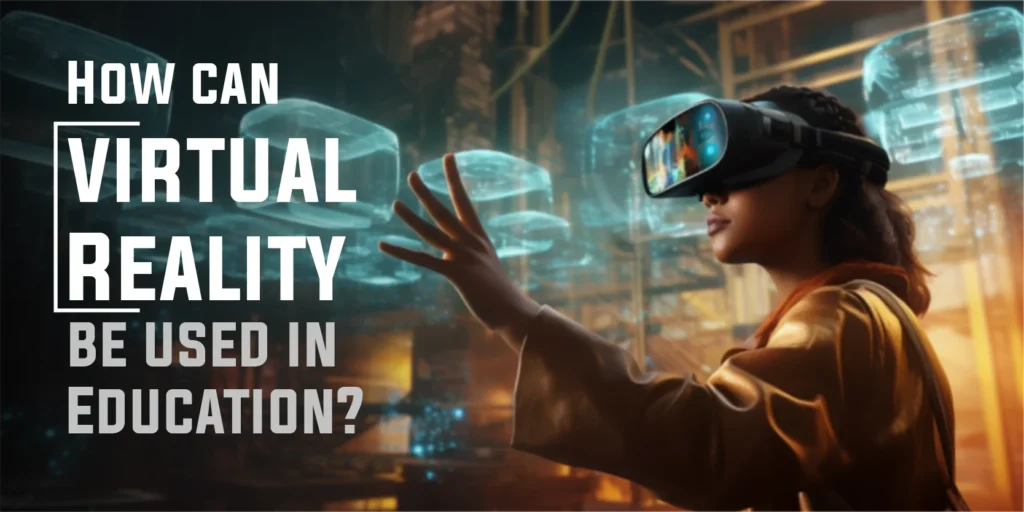Significant Impact of Virtual Reality in Education
| “Virtual Reality is Artificial computer-generated environment.” |
Since Education is about Exploring and Introducing new Technologies and Innovations, Virtual reality in education is one of the latest technological innovations in the education sector.
Nowadays, using VR applications in learning is mandatory for educators. Experiencing Virtual Reality is not just like sitting in front of a screen and watching a display. However, it is about living a Virtual life, experiencing and interacting in a generated 3d environment. You can touch, feel, hear, or smell the objects.
This article explores how Virtual Reality plays a role in Education.
How can virtual Reality be used in Education?

The use of VR in Education is compulsory in today’s world. Since it provides interactive, engaging, and memorable lessons for students, making the education process impactful.
Undoubtedly, this new culture will be beneficial for teachers and students.
You can use this technology in many ways. While teaching science concepts, mathematical calculations, etc.
You want to teach your students a medical activity that needs a human body. Now, you must prepare a VR environment and teach them even in the classroom.
At some moment, if you want to teach forecasts and something like that, create an environment and take your students on virtual trips for better understanding.
Advantages of Virtual Reality in Education:
Education and Virtual Reality are perfect combinations of authentic and reliable research. You can explore new tech innovations in Education by utilizing emerging Virtual Reality.
Although using VR in classrooms provides numerous benefits, the following are some prominent benefits of using Virtual Reality Teaching Tools.
Engaging Technology:

Since it provides real-time experiences and information, students are more interested in such technology-based Education. It can keep students engaged and busy in exporting new technologies and innovations. In short, VR in Education makes the learning and teaching methods enjoyable and fun related.
Experimental Learning:

Virtual Reality teaching tools is all about experience. Therefore, the hassle of making complex and challenging presentations is gone. Students can experience all sensitive and complex concepts in educational institutes using VR.
Regardless of field trips, scientific innovation, and dangerous exploration, students can practically practice through VR in classrooms.
Interactive Learning:

Since Virtual Reality in education encourages students to engage in interactive learning, students gain more confidence and build strong personalities. VR allows students to keep themselves involved in manipulating objects, Virtual environments, and problem-solving activities. Eventually, it will help to develop critical thinking and a detailed understanding of sensitive topics.
Personalized learning system:

Virtual Reality in educational curriculum allows you to experience risky experiments safely. Therefore, you can learn medical concepts without hurting patients. You can find new ways of treatment to make the complicated process easy.
Surprisingly, VR-based applications share phenomenal knowledge in anatomy, blood pressure, etc., providing a safe environment to experiment with different concepts without risk.
In short, bringing emerging virtual Reality into the health sector helps educators teach complex concepts with understandable methodologies.
Virtual Field Trip:

Children love to go on trips and enjoy the peaceful environment. A Virtual field trip is another level of casual travel, and children ultimately love this type of trip. Surprisingly, Virtual trips play a crucial role in the growth of a child’s Education.
Experiencing bookish knowledge and concepts increases the curiosity and interest of students. However, such virtual field trips are impossible to practice daily, but at least students can experience such valuable educational stuff.
On the other hand, some physical trips are also almost impossible because of some natural boundaries you can experience through Virtual Reality.
Furthermore, Virtual trips provide unlimited opportunities for students to travel to different locations and cities, experience other weather conditions, and much more.
Explaining theory-based dry and complex concepts to students is a critical challenge for teachers and students both.
Collaboration in Group Learning:
Virtua Reality in Education helps to fill the gap between teachers and students. Students can communicate verbally in the presence of their avatar. It also helps to boost their confidence and make them comfortable in classrooms.
Through VR-supported Wearable technology, you can communicate with your teachers and classmates while experiencing virtual Reality at the same time.
Cost Effective system:
Educational institutes are supposed to invest huge amounts of money to teach their students advanced technology. Engineering, medicine, computers, and art equipment sometimes require more money than the assigned budget.
However, in such situations, you need to spend more money. In contrast, Virtual Reality requires huge investment, but it will be beneficial in the long term. You have to invest one time and then enjoy the benefits. Although it costs you more compared to casual machines, you will find VR more cost-effective in the future.
Learn Empathy:
VR in Education helps teachers build an empathic nature. They try to create situations through Virtual Reality for their students to experience and learn to stay humble.
Students explore different cultures, lifestyles, statuses, and other practices so they evolve and take their blessings for granted. In short, VR for educational engagement provides technical skills and learning and builds soft skills.
Critical Analysis of Virtual Reality in Education:
Although it is valuable to incorporate VR in Education, you must be aware of what stage it should be presented to your students. Also, it’s only suitable for some levels of students. So many concepts can be thought of manually, while some need advanced technology.
Since Artificial Intelligence supports VR, you can not blindly rely on data driven by VR.
Final Verdict:
Virtual Reality in education is a powerful tool for enhancing the education industry. Undoubtedly, it can covert traditional, outdated education systems into futuristic, advanced, technology-based, active education systems.

Similar Posts
Can Docparser’s OCR Magic Transform Your PDF Workflow?
Is Freetubespot the One-Stop Solution For Free, High-Quality Video Content?
Leveraging Technology for Success in Australian Business